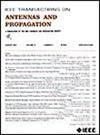Machine Learning-Based Design Scheme for Multifunctional Antenna Arrays With Reconfigurable Scattering Patterns
IF 4.6
1区 计算机科学
Q1 ENGINEERING, ELECTRICAL & ELECTRONIC
引用次数: 0
Abstract
A machine learning-based multifunctional antenna array design scheme (ML-MAADS), including a structure design module and a scattering beam steering module, is proposed for the multifunctional antenna array with reconfigurable scattering patterns in this work. The structure design module enables the rapid structure codesign of radiation and scattering for the reconfigurable array element, while the scattering beam steering module facilitates the near real-time beam steering for reconfigurable scattering patterns. To validate the ML-MAADS, a reconfigurable antenna element integrated with two positive-intrinsic-negative (p-i-n) diodes is designed using the structure design module, to construct a multifunctional antenna array. The antenna array serves three functions. First, it enables y-polarized ±60° radiation beam scanning, acting as a phased array; second, it exhibits low-scattering performance under x-polarized incident wave; third, it supports reconfigurable scattering pattern in the x-polarization, functioning as a programmable coding reflected metasurface. Benefiting from the structure design, the reconfigurable scattering characteristics do not affect the antenna’s radiation, thus enabling simultaneous operation in both radiation and scattering functions. Following the structure design, the scattering beam steering module is employed to achieve real-time beam steering (including single, dual, and vortex beams) for a reconfigurable scattering pattern, with the prediction accuracy exceeding 93%. The ML-MAADS provides designers with a promising comprehensive solution for complex multifunctional antenna synthesis in the future.基于机器学习的可重构散射模式多功能天线阵列设计方案
针对具有可重构散射模式的多功能天线阵,提出了一种基于机器学习的多功能天线阵设计方案(ML-MAADS),包括结构设计模块和散射波束引导模块。结构设计模块实现了可重构阵列单元辐射和散射的快速结构协同设计,而散射波束导向模块实现了可重构散射方向图的近实时波束导向。为了验证ML-MAADS,利用结构设计模块设计了一个可重构天线单元,该天线单元集成了两个正本质负(p-i-n)二极管,以构建多功能天线阵列。天线阵有三个功能。首先,它可以实现y偏振±60°辐射束扫描,作为相控阵;其次,在x偏振入射波下具有低散射性能;第三,它支持可重构的x偏振散射模式,作为可编程编码反射超表面。得益于这种结构设计,可重构的散射特性不会影响天线的辐射,从而实现辐射和散射功能的同时运行。在结构设计的基础上,利用散射波束导向模块实现可重构散射模式的实时波束导向(包括单波束、双波束和涡旋波束),预测精度超过93%。ML-MAADS为设计人员提供了未来复杂多功能天线综合的有前途的综合解决方案。
本文章由计算机程序翻译,如有差异,请以英文原文为准。
求助全文
约1分钟内获得全文
求助全文
来源期刊
CiteScore
10.40
自引率
28.10%
发文量
968
审稿时长
4.7 months
期刊介绍:
IEEE Transactions on Antennas and Propagation includes theoretical and experimental advances in antennas, including design and development, and in the propagation of electromagnetic waves, including scattering, diffraction, and interaction with continuous media; and applications pertaining to antennas and propagation, such as remote sensing, applied optics, and millimeter and submillimeter wave techniques

 求助内容:
求助内容: 应助结果提醒方式:
应助结果提醒方式:


